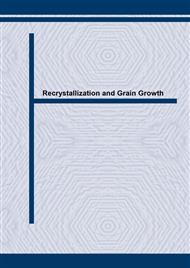p.697
p.707
p.715
p.727
p.733
p.739
p.745
p.751
p.757
Effect of Anisotropic Interfacial Energy on Grain Boundary Distributions during Grain Growth
Abstract:
Through simulations with the moving finite element program GRAIN3D, we have studied the effect of anisotropic grain boundary energy on the distribution of boundary types in a polycrystal during normal grain growth. An energy function similar to that hypothesized for magnesia was used, and the simulated grain boundary distributions were found to agree well with measured distributions. The simulated results suggest that initially random microstructures develop nearly steady state grain boundary distributions that have local maxima and minima corresponding to local minima and maxima, respectively, of the energy function.
Info:
Periodical:
Pages:
733-738
Citation:
Online since:
October 2004
Keywords:
Price:
Сopyright:
© 2004 Trans Tech Publications Ltd. All Rights Reserved
Share:
Citation:


